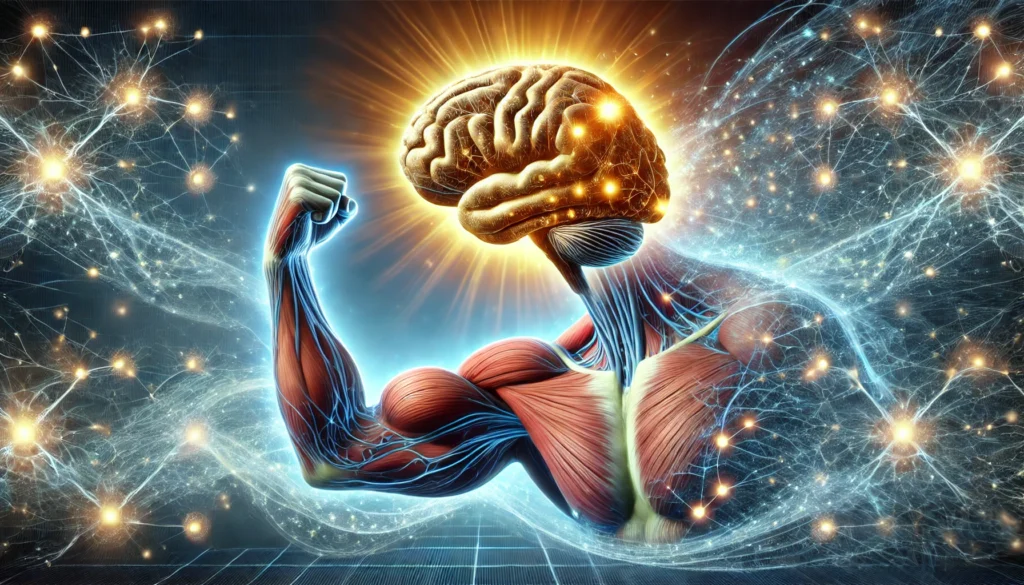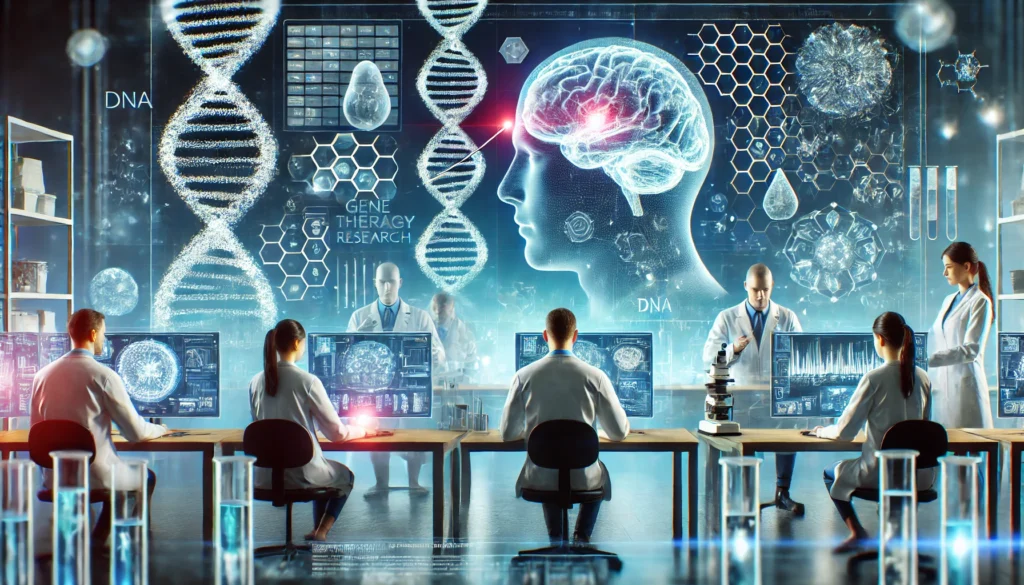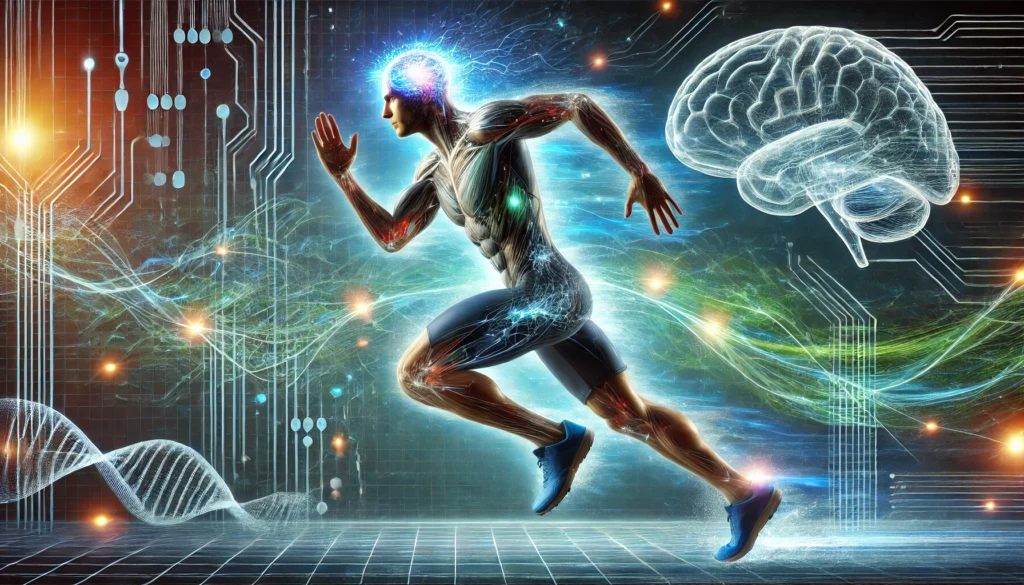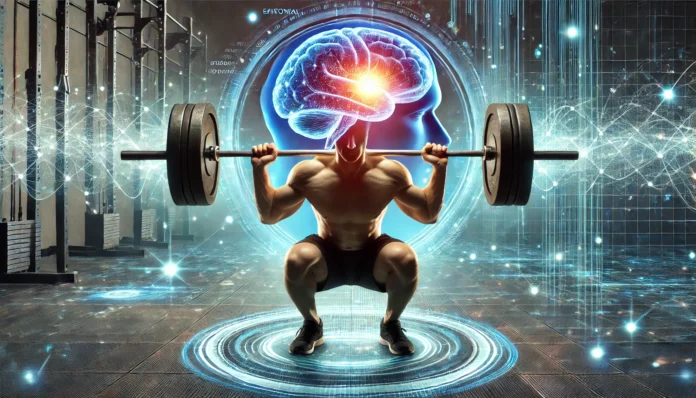The profound connection between physical fitness and cognitive well-being has become an area of immense scientific interest. Strength training, long regarded as essential for muscle development and overall physical health, is now recognized for its significant impact on brain function and mental performance. Emerging research demonstrates that resistance training not only enhances memory and cognitive abilities but also contributes to the prevention of neurodegenerative disorders such as Alzheimer’s disease and Parkinson’s disease. Furthermore, as scientific advancements continue to push the boundaries of medicine, gene therapy is emerging as a potential tool for neural enhancement. Understanding how strength training influences brain health and how gene therapy may complement these benefits provides a fascinating glimpse into the future of cognitive enhancement and disease prevention.
You may also like: Best Strength Training Routine for Men: How Prostate Health Supplements Support Muscle Recovery and Performance
The Cognitive Benefits of Strength Training
Strength training, also known as resistance training, involves exercises designed to build muscle mass, strength, and endurance. Activities such as weightlifting, bodyweight exercises, and resistance band workouts contribute to improved physical health, but their effects extend far beyond the musculoskeletal system. The cognitive benefits of strength training are increasingly supported by scientific evidence, demonstrating that regular resistance exercises enhance brain plasticity, improve memory retention, and increase mental clarity.
Studies have shown that individuals who engage in strength training experience improved executive function, which includes skills such as decision-making, problem-solving, and emotional regulation. This enhanced performance may also be tied to the body’s ability to recover and rebuild more efficiently at the cellular level. Additionally, strength training has been linked to increased levels of brain-derived neurotrophic factor (BDNF), a protein that supports the growth and maintenance of neurons. Higher BDNF levels are associated with enhanced cognitive function and protection against neurodegenerative diseases.
The Role of Neurogenesis and Synaptic Plasticity
One of the most remarkable effects of strength training on brain health is its ability to stimulate neurogenesis, the process of generating new neurons. For decades, scientists believed that adults could not generate new brain cells. However, recent research has demonstrated that neurogenesis continues throughout life, particularly in the hippocampus, a region crucial for memory formation and learning. Strength training facilitates this process by increasing the production of neurotransmitters such as dopamine and serotonin, which play essential roles in cognitive function and mood regulation.
Additionally, strength training enhances synaptic plasticity, the ability of neurons to form new connections. This process is fundamental to learning and memory, as it allows the brain to adapt to new information and experiences. By promoting neurogenesis and synaptic plasticity, resistance training helps maintain cognitive sharpness and reduces the risk of cognitive decline.
Innovative developments such as cloning therapy for muscle regeneration may offer insights into how cellular growth could be mirrored in brain tissue. This emerging field explores whether regenerative approaches could complement strength training’s neurological benefits.

The Impact of Strength Training on Mood and Mental Resilience
Beyond its direct impact on cognitive abilities, strength training plays a critical role in mental health. Regular resistance training has been shown to reduce symptoms of anxiety and depression, improve self-esteem, and enhance overall psychological resilience. The physiological mechanisms behind these benefits include the release of endorphins, which act as natural mood enhancers, and the reduction of cortisol, a stress hormone that negatively impacts cognitive function.
Additionally, strength training encourages better sleep quality, which is essential for memory consolidation and mental recovery. Individuals who incorporate strength training into their routines often report improved focus, reduced mental fatigue, and greater emotional stability. As strength training evolves, future developments may further enhance its mental health benefits. Advances in training methodologies are likely to target both physical and psychological well-being more precisely.
Gene Therapy and Neural Enhancement
As the field of genetic medicine advances, gene therapy is emerging as a potential tool for enhancing brain function and treating neurological disorders. Gene therapy involves modifying or replacing defective genes to treat or prevent disease. One of the most promising applications of gene therapy in neuroscience is its potential to address genetic disorders that affect cognitive function, such as Huntington’s disease and certain forms of dementia. Scientists are exploring the use of gene addition, a process in which functional genes are introduced into cells to replace missing or defective ones. This intersection of genetic therapy and physical conditioning may revolutionize the way strength training is applied for brain enhancement.
Additionally, gene replacement therapy, a method that involves swapping faulty genes with healthy copies, is being investigated for its potential to enhance memory, learning, and overall neural performance. These groundbreaking advancements raise important questions about the ethical implications of genetic modifications for cognitive enhancement. Despite that, breakthroughs in cell and gene therapy are paving the way for unprecedented progress in treating and potentially enhancing neurological functions. These developments underscore the urgency of ethical and regulatory oversight as the field advances.
The Limitations and Ethical Considerations of Gene Therapy
Despite its potential, gene therapy faces several challenges and ethical considerations. One of the main limitations of gene therapy is the risk of unintended genetic alterations, which could lead to unforeseen health complications. Furthermore, the long-term effects of gene therapy on brain function remain largely unknown, requiring extensive research and clinical trials before widespread application. Ethical concerns also arise regarding the use of gene therapy for cognitive enhancement in healthy individuals.
Particularly contentious is the debate surrounding genetic interventions before birth. Editing the genome at such an early stage raises complex questions about consent, equity, and long-term societal implications. While gene therapy has the potential to improve brain function and treat neurological disorders, questions remain about its accessibility, fairness, and potential for misuse. As scientists continue to explore the pros and cons of gene therapy, it is essential to establish clear guidelines and ethical frameworks to ensure its responsible use.
Integrating Strength Training and Gene Therapy for Optimal Brain Health
The intersection of strength training and gene therapy presents a compelling opportunity for optimizing brain health. While resistance training naturally enhances cognitive function through neurogenesis and synaptic plasticity, gene therapy may offer additional benefits by targeting specific genetic factors that influence brain function. Future research may explore the potential synergy between these two approaches, examining whether gene therapy can amplify the cognitive benefits of strength training. To that end, it is essential to understand the different types of gene therapy and their mechanisms. Each therapy offers unique applications that could be tailored to support brain function in conjunction with physical training.
Additionally, scientists may investigate how strength training influences the expression of therapeutic genes, potentially leading to novel treatment strategies for neurodegenerative diseases. As our understanding of the human genome expands, integrating physical fitness with genetic interventions could revolutionize the way we approach cognitive enhancement and brain health.

Frequently Asked Questions (FAQ)
1. What is the definition of gene addition?
Gene addition is a technique in gene therapy where a new, functional gene is introduced into a patient’s cells to replace or supplement a defective gene. This process does not remove the faulty gene but rather adds a working copy to help restore normal function. The definition of gene addition is crucial in understanding how gene therapy operates, especially in treating genetic disorders. Scientists use viral vectors or other delivery systems to integrate the therapeutic gene into the patient’s genome. This method is particularly beneficial for conditions where simply adding a functioning gene can alleviate symptoms or correct a deficiency.
2. How does gene therapy work?
Gene therapy works by modifying or replacing faulty genes within a patient’s cells to treat or prevent disease. The process typically involves delivering a therapeutic gene using a viral vector or other delivery mechanism to target specific cells. The delivery approach—whether conducted inside the body (in vivo) or outside the body before reinsertion (ex vivo)—significantly impacts therapeutic precision and safety. Once inside the body, the new gene can either replace a defective gene, supplement its function, or instruct the body to produce a missing protein. The success of gene therapy depends on ensuring that the therapeutic gene is correctly delivered and expressed in the right cells. Over the years, advances in gene therapy have made it a promising treatment for various genetic disorders, cancers, and even some chronic conditions.
3. What are some limitations of gene therapy?
There are several limitations to gene therapy, including potential immune system reactions, difficulty in precisely targeting affected cells, and the possibility of unintended genetic changes. One of the primary limitations of gene therapy is the risk of an immune response against the viral vectors used for delivery, which can reduce treatment effectiveness. Additionally, the integration of the therapeutic gene into the genome can sometimes lead to mutations or disruptions in other genes. The cost and complexity of gene therapy research and treatment also pose significant challenges. Despite these hurdles, ongoing advancements are improving the safety and efficiency of gene therapy applications.
4. Can gene therapy add chromosomes?
Gene therapy does not add entire chromosomes but can introduce specific therapeutic genes to replace or repair faulty ones. While scientists can insert new genes into cells, adding a full chromosome would be much more complex and could lead to unintended consequences. The goal of gene therapy is to modify existing genetic material without disrupting the overall chromosomal structure. Researchers continue to explore innovative ways to manipulate genes at a more granular level to treat genetic disorders effectively. However, the ability to add whole chromosomes remains outside the current scope of gene therapy techniques.
5. What is germline therapy, and how does it differ from somatic gene therapy?
Germline therapy involves making genetic modifications to reproductive cells (sperm, eggs, or embryos), which means these changes can be passed on to future generations. In contrast, somatic gene therapy targets non-reproductive cells, meaning the changes affect only the treated individual and do not get inherited. Germline therapy has the potential to eliminate genetic diseases from a family lineage, but it also raises ethical concerns about genetic modifications in future generations. Due to these ethical and safety issues, germline therapy is currently not widely practiced or legally permitted in many countries. Research in this area is ongoing, with careful consideration of the long-term implications.
6. How can gene therapy improve human society?
Gene therapy has the potential to revolutionize medicine by providing long-term treatments or even cures for previously untreatable diseases. By addressing genetic disorders at their root cause, gene therapy can reduce the burden of chronic conditions on healthcare systems and improve patients’ quality of life. The technology also opens new doors for personalized medicine, where treatments are tailored to an individual’s genetic makeup. Advances in genetic engineering are expanding these possibilities by allowing highly targeted modifications at the molecular level. These innovations help personalize care while also enhancing treatment efficacy across a wider range of conditions.
7. What is the goal of gene therapy in pathophysiology?
The goal of gene therapy in pathophysiology is to correct the underlying genetic causes of disease rather than just treating symptoms. This approach aims to introduce functional genes that either replace, repair, or supplement defective ones in a patient’s cells. By doing so, gene therapy can provide long-lasting or even permanent relief from certain genetic disorders. Researchers focus on developing precise delivery methods to ensure that therapeutic genes reach the right cells and function effectively. Over time, this strategy may lead to more effective and sustainable treatments for a wide range of conditions, including cancer, immune deficiencies, and neurodegenerative diseases.
Similar to gene therapy, stem cell research is advancing the possibility of regenerative treatments that repair damaged tissues at the source. These innovations work hand in hand to address the root causes of neurological and systemic diseases.
8. How is the correct gene added to the cells during gene therapy?
The correct gene is added to cells using a variety of delivery mechanisms, with viral vectors being the most common. Scientists modify viruses to carry therapeutic genes and deliver them into the patient’s target cells without causing disease. Other methods include non-viral delivery techniques like lipid nanoparticles and CRISPR-based gene editing tools. The success of gene therapy depends on ensuring that the introduced gene is expressed correctly and remains stable within the cells. Researchers continue to refine these delivery systems to improve efficiency and reduce potential side effects.
One revolutionary development in gene delivery and editing is CRISPR, which has shown success in treating diseases like sickle cell anemia. Its precision and versatility offer exciting potential for future gene therapies targeting brain function.
9. What are the pros and cons of gene therapy?
The pros of gene therapy include the potential to cure genetic disorders, reduce reliance on lifelong treatments, and improve patients’ overall quality of life. Additionally, gene therapy may offer new treatment options for diseases that currently have no cure. However, the cons include high costs, ethical concerns, potential immune reactions, and the risk of unintended genetic mutations. One of the key challenges is ensuring that therapeutic genes integrate safely and function as intended without causing adverse effects. Despite these challenges, gene therapy remains a promising field with continuous advancements that may overcome many of its current limitations.
10. Is gene therapy safe?
Gene therapy is generally considered safe when conducted under controlled clinical trials and regulatory guidelines. However, safety concerns still exist, including immune responses to viral vectors, unintended genetic alterations, and potential long-term effects that are not yet fully understood. Researchers work diligently to improve gene therapy’s safety by developing more precise gene-editing techniques and better delivery systems. As scientific knowledge advances, ongoing clinical trials help identify and address potential risks. Ultimately, the safety of gene therapy depends on careful implementation, thorough monitoring, and continued research to refine its applications.

Conclusion: Strength Training and Genetic Advancements in Brain Health
Strength training is a powerful tool for enhancing cognitive function, improving mental resilience, and reducing the risk of neurodegenerative diseases. By promoting neurogenesis, increasing neurotransmitter production, and fostering synaptic plasticity, resistance training plays a crucial role in maintaining brain health. At the same time, gene therapy offers promising possibilities for addressing genetic brain disorders and enhancing neural function. While gene therapy presents exciting opportunities, it also raises ethical and scientific challenges that must be carefully addressed. The integration of strength training and gene therapy represents a frontier of research that has the potential to transform cognitive health and redefine the limits of human potential. As science continues to evolve, a deeper understanding of these interventions will pave the way for innovative strategies to support lifelong brain health and mental performance.
genetic modification benefits, gene therapy applications, DNA modification techniques, hereditary disease treatment, gene editing in medicine, genetic research breakthroughs, future of genetic therapy, ethical concerns in gene therapy, genetic disorder solutions, advanced medical biotechnology, precision medicine and genes, genetic engineering for health, molecular medicine advancements, inherited disease prevention, therapeutic genetic interventions, genome editing innovations, personalized genetic treatments, regenerative medicine strategies, genetic science advancements, cellular therapy techniques
Further Reading:
Exercising to keep the brain young: Latest research and expert opinions
Disclaimer
The information contained in this article is provided for general informational purposes only and is not intended to serve as medical, legal, or professional advice. While Health11News strives to present accurate, up-to-date, and reliable content, no warranty or guarantee, expressed or implied, is made regarding the completeness, accuracy, or adequacy of the information provided. Readers are strongly advised to seek the guidance of a qualified healthcare provider or other relevant professionals before acting on any information contained in this article. Health11News, its authors, editors, and contributors expressly disclaim any liability for any damages, losses, or consequences arising directly or indirectly from the use, interpretation, or reliance on any information presented herein. The views and opinions expressed in this article are those of the author(s) and do not necessarily reflect the official policies or positions of Health11News.


